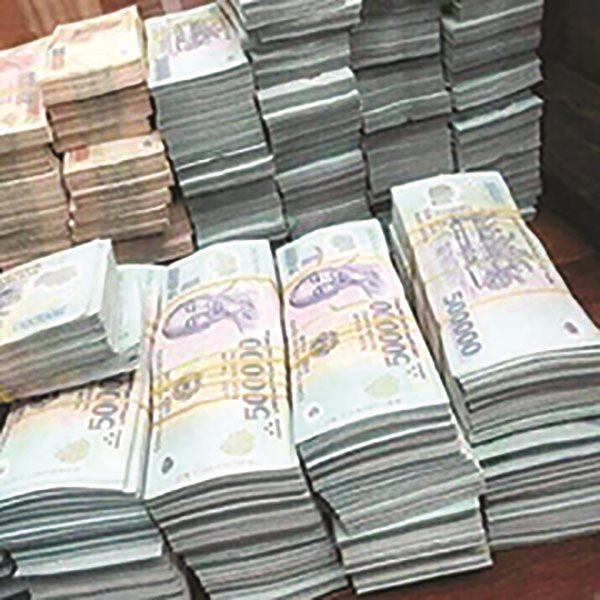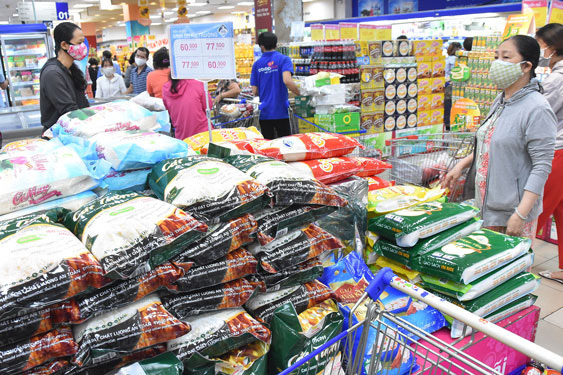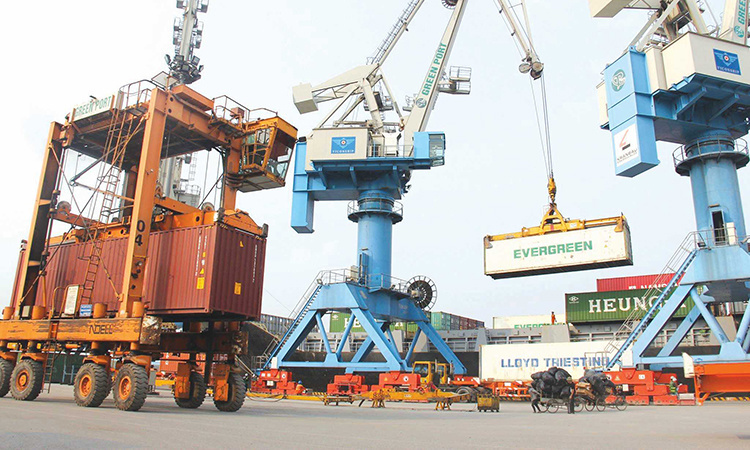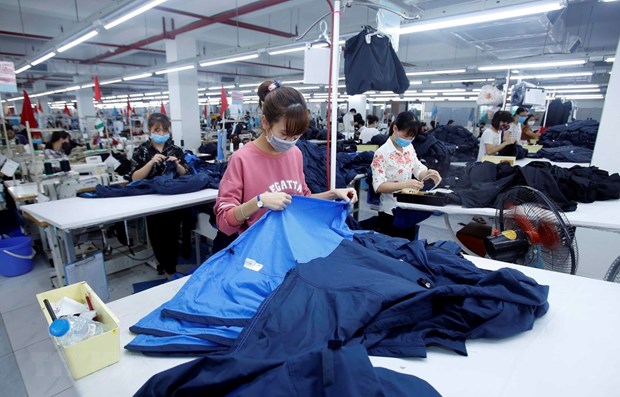- © Copyright of Vietnamnet Global.
- Tel: 024 3772 7988 Fax: (024) 37722734
- Email: [email protected]
GDP
Update news GDP
Vietnam's public debt payment at safe levels after pandemic
 The ratio of public debt to GDP is not too high, but the pressure of debt repayment in both VND and foreign currencies will increase in 2020-2021.
The ratio of public debt to GDP is not too high, but the pressure of debt repayment in both VND and foreign currencies will increase in 2020-2021.
Money oversupply: sign of weak growth
 Last week, interbank liquidity was in excess and the interest rate dropped to a record low, signs showing that capital has become ‘stagnant’.
Last week, interbank liquidity was in excess and the interest rate dropped to a record low, signs showing that capital has become ‘stagnant’.
Vietnamese enterprises encouraged to focus on home market
 Focusing on the home market is one of the important solutions that will help enterprises restore production and business after Covid-19 ends, experts say.
Focusing on the home market is one of the important solutions that will help enterprises restore production and business after Covid-19 ends, experts say.
Vietnamese optimism believed to help economy recover quickly
 Restaurants and eateries have been crowded recently, following the social distancing period. Analysts believe this indicates a rapid recovery of the economy after the epidemic.
Restaurants and eateries have been crowded recently, following the social distancing period. Analysts believe this indicates a rapid recovery of the economy after the epidemic.
Senior economist projects "swoosh-shaped" recovery for Vietnam
 It won’t be a V-shaped recovery, but a swoosh-shaped recovery like Nike’s logo: the economy will go down and then bounce back beginning in 2021, according to BIDV’s chief economist Can Van Luc.
It won’t be a V-shaped recovery, but a swoosh-shaped recovery like Nike’s logo: the economy will go down and then bounce back beginning in 2021, according to BIDV’s chief economist Can Van Luc.
Economists warn of stagflation because of COVID-19
 Vietnam needs to keep inflation and interest rates at low levels, stabilize the exchange rate, accelerate public investments, and improve the investment environment, economists say.
Vietnam needs to keep inflation and interest rates at low levels, stabilize the exchange rate, accelerate public investments, and improve the investment environment, economists say.
Speedier recovery up ahead for some
Industrial and residential properties could be the sectors grasping the most upcoming attention in the real estate market of Vietnam, Indonesia, and the Philippines – three of the ASEAN’s fastest-growing economies.
Economist suggests solution for Vietnam to become powerful after pandemic
 Dr Vu Minh Khuong from Lee Kuan Yew School of Public Policy in Singapore thinks that large economic groups such as Vingroup should develop industrial zones (IZs), not only for Vietnam, but also for Southeast Asia.
Dr Vu Minh Khuong from Lee Kuan Yew School of Public Policy in Singapore thinks that large economic groups such as Vingroup should develop industrial zones (IZs), not only for Vietnam, but also for Southeast Asia.
Two scenarios for Vietnam's economic recovery
 Vietnam has to be very cautious when choosing and implementing a plan to reactivate the economy.
Vietnam has to be very cautious when choosing and implementing a plan to reactivate the economy.
Domestic market could be engine for Vietnamese enterprises' growth
 If enterprises can exploit the domestic market well, they will be able to overcome the Covid-19 crisis, analysts say.
If enterprises can exploit the domestic market well, they will be able to overcome the Covid-19 crisis, analysts say.
Revised Vietnam's GDP goals to buttress growth
 The aftermath of the health crisis has prompted Vietnam to consider adjusting its economic growth target,
The aftermath of the health crisis has prompted Vietnam to consider adjusting its economic growth target,
Vietnamese businesses ‘swim against the stream’ to seek profit
 While many businesses have had to take big losses because of Covid-19, other businesses have reported profits with 2-digit growth rates.
While many businesses have had to take big losses because of Covid-19, other businesses have reported profits with 2-digit growth rates.
Vietnam ready for swift actions to boost economy
 The ongoing health crisis has been taking a heavy toll on the Vietnamese economy.
The ongoing health crisis has been taking a heavy toll on the Vietnamese economy.
WB: EVFTA could lift Vietnam’s exports by 12 percent by 2030
 The World Bank (WB) has predicted that the EU-Vietnam Free Trade Agreement (EVFTA) could help Vietnam’s GDP and exports grow 2.4 percent and 12 percent, respectively, by 2030, the Ministry of Industry and Trade (MoIT) has reported.
The World Bank (WB) has predicted that the EU-Vietnam Free Trade Agreement (EVFTA) could help Vietnam’s GDP and exports grow 2.4 percent and 12 percent, respectively, by 2030, the Ministry of Industry and Trade (MoIT) has reported.
Debt guarantee: light at the end of tunnel for Vietnamese SMEs
 Some experts believe that the government needs to come forward and provide a guarantee for SMEs (small and medium enterprises) to access bank debts.
Some experts believe that the government needs to come forward and provide a guarantee for SMEs (small and medium enterprises) to access bank debts.
It may take one year to recover VN economy: experts
 A low GDP growth rate is unavoidable in 2020 as the economy has been seriously affected by Covid-19.
A low GDP growth rate is unavoidable in 2020 as the economy has been seriously affected by Covid-19.
Vietnam economy accelerates to get back to normal state
 With the resumption of key economic sectors' activities, such as manufacturing, services and retail, Vietnam’s economy is accelerating to get back to its normal state.
With the resumption of key economic sectors' activities, such as manufacturing, services and retail, Vietnam’s economy is accelerating to get back to its normal state.
Greenback cools, pressure on VND/USD exchange rate eases
 As the dollar price has decreased in the international market, the official exchange rate announced by the State Bank of Vietnam (SBV) and dollar market price have also decreased slightly.
As the dollar price has decreased in the international market, the official exchange rate announced by the State Bank of Vietnam (SBV) and dollar market price have also decreased slightly.
Vietnam's GDP growth to decline because of COVID-19
 VinaCapital has predicted a 3 percent GDP growth rate reduction because of Covid-19, while Fitch has projected a modest growth rate of 3.3 percent, and ADB 4.8 percent.
VinaCapital has predicted a 3 percent GDP growth rate reduction because of Covid-19, while Fitch has projected a modest growth rate of 3.3 percent, and ADB 4.8 percent.
VN businesses switch from ‘standby’ to ‘run’ mode to earn money
 Unable to wait for the pandemic to end and seeing revenue drop to zero, businesses have been trying every method to earn money in the Covid-19 crisis.
Unable to wait for the pandemic to end and seeing revenue drop to zero, businesses have been trying every method to earn money in the Covid-19 crisis.



















